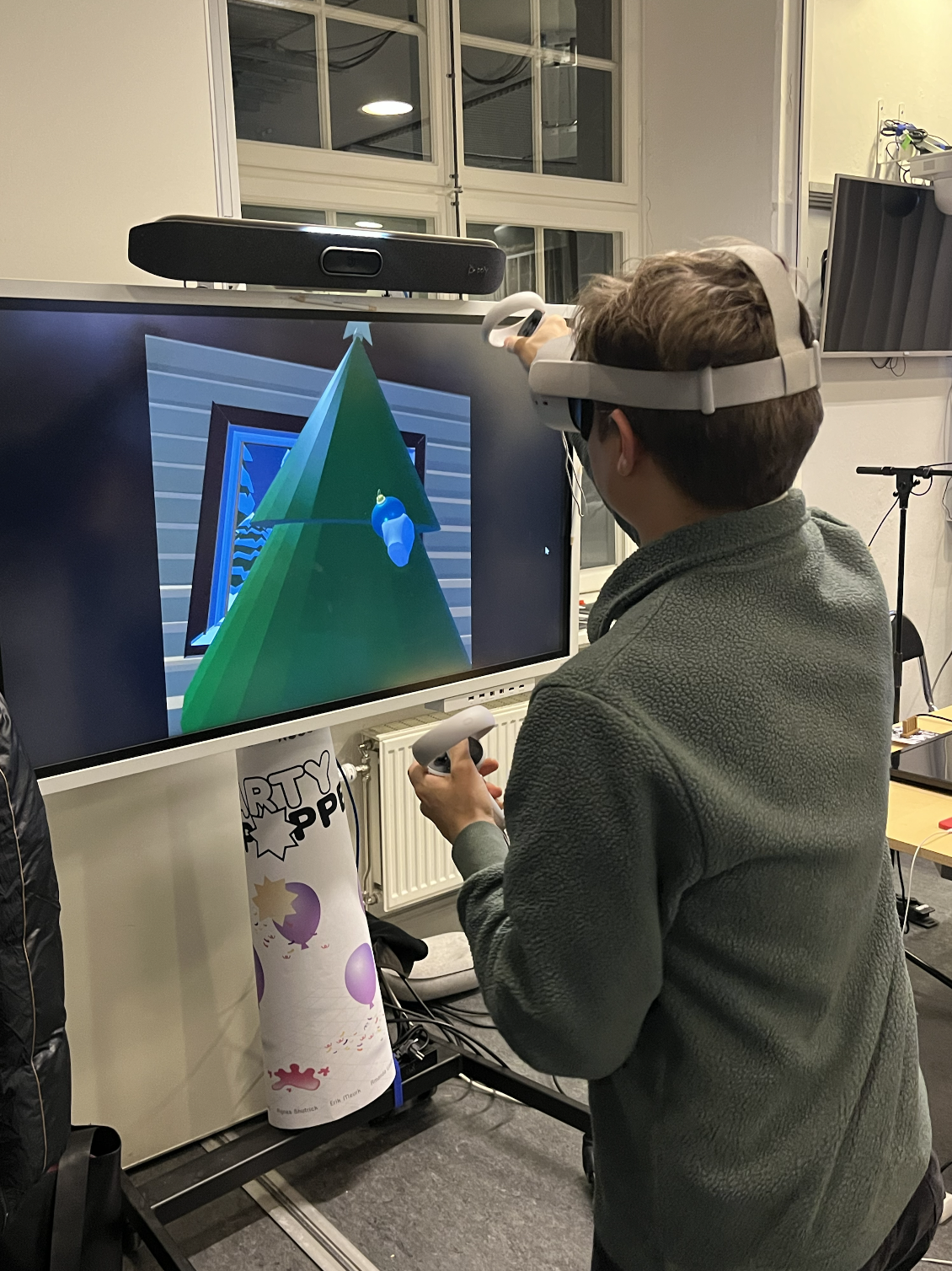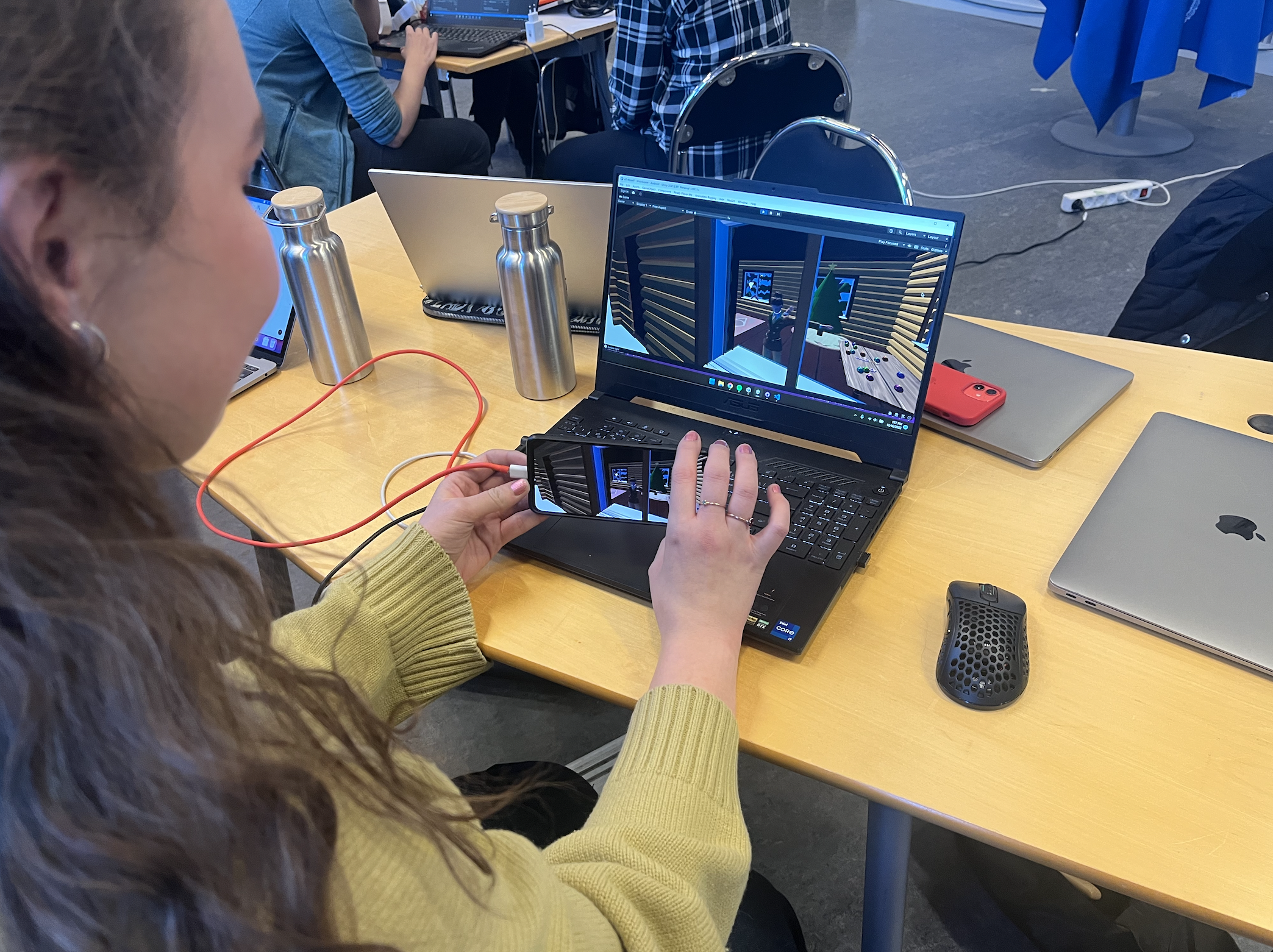Goal and motivation of project
Elf & Myself is a Christmas experience that bridges the gap between the
virtual- and outside world. A VR-user steps into a cozy christmas cabin
where they can decorate a tree, while an outside user takes the role of
an elf that peeks into the windows of the cabin and controls their point
of view through the gyroscope in a smartphone.
One of the motivations behind Elf & Myself was that we wanted to close
the distance by breaking the wall between the VR-player and the
audience. VR is usually quite an isolated experience where interactions
with the outside world and observers is non-existent or restricted.
Instead of merely casting the HMD-users view to a public screen, we
wanted to provide the outside observer with a higher sense of immersion
by allowing them “peep” into the VR-world and control their point of
view through embodied interaction. The outside spectator’s position was
also visualized in the VR-space.
Our goal was therefore to create a closer connection between the
audience and the player immersed in VR. Whilst doing this we wanted to
deepen our knowledge in graphics and interactions by exploring new
techniques and novel means of interaction. We also wanted to work with
lights and shadows to create a more realistic, immersive experience and
to create a cozy atmosphere in line with our Christmas theme. It was
created as a part of the course Advanced Graphics and Interaction in
just 4 weeks during the winter of 2022.
Graphics and interaction technologies used and developed
The software Ready Player Me offers customizable 3D avatars created for
VR experiences (especially the Metaverse). The avatar was imported using
the Ready Player Me SDK and acts like a normal 3D asset in Unity. For
the skeletal movement of the avatar, the Animation Rigging package was
used. Animation rigging was used to define the bone structure of the
character and assigning skin weights to the mesh, which determines how
the vertices of the mesh are deformed when the bones move. Once the
character was rigged, it could be animated by moving the bones in the
hierarchy, which will cause the mesh to deform and create movements. For
us, the movements of the avatar were based on the hands and head
movements of the player connected with the Oculus VR kit. Using the
avatar from Ready Player Me allowed us to spend less time on advanced
skeleton modeling in Blender and more time on other graphics and
interactions that were crucial for the experience.
To synchronize Elf & Myself between the VR-player and the audience, we
first wanted to videostream an in-game camera from Unity that the
audience could see. The problem was that we had to stream from the
built-in app in the Oculus Quest 2 headset. This showed to be tricky, as
there were no current solutions to stream an in-game camera from an
Android build, only from PC. Instead, we used NormCore to keep the state
of all clients the same. Normcore is a networking plugin and hosting
service created by Normal and is built to enable multiplayer gameplay in
a quick and efficient way. Using NormCore, we could use different
scripts and solutions to send data about different objects' orientation
in space to keep everything up to date, showing the same gameplay on
both the audience and VR-player view.
All models were created using Blender, additionally some procedural
textures were developed, such as the gingerbread-cookie and the
fireplace stone. In order to export and import the procedural textures
from Blender to Unity, the objects were UV unwrapped and the textures
baked into images, a diffuse map for color information and a normal map.
These were then applied to the imported model in Unity. This not only
enabled us to use the procedural textures created in Blender, but can
also save render time.
We did use some external resources. The crackling noise of the fireplace
is from freesound.org. The avatar is from Ready Player Me, which is a
Metaverse avatar creator.
Challenges & Obstacles
In order to break down the wall between the HMD user and the outside
spectator we deemed it critical to create realistic avatars representing
both users. We decided to use the Oculus Quest 2 since we are familiar
with it and due to the mobility afforded by it being able to run it
cordless. However, that also meant we only had three points of tracking
which was a big challenge when creating the representation of the
VR-player. It is evident that it is very challenging, if not impossible,
to create fully realistic human movement based on only three points of
tracking. With regards to the outside spectator we only had one
dimension of tracking - the rotation, so it was also a big challenge to
represent that user in VR.
Due to the time restriction of this project, it was also a challenge to
prioritize the work and still explore advanced and, to us, novel
graphics and interaction techniques. Based on previous experience, we
knew that when working with the Oculus Quest 2, another big challenge is
to balance graphics and performance.
The biggest obstacle was the restricted time we had to develop this
project, 4 weeks. As mentioned, we had to prioritize our work. The end
product has managed to achieve what we set out to do, that is to narrow
the bridge between the virtual- and outside-world using embodied
interaction. However, it would have benefited from more throughout user
testing since it does contain some bugs and is somewhat unreliable.
Another obstacle was that all of us advanced our Blender skills out of
interest and therefore wanted to add more things into the scene which
was troubling for the headsets performance. When putting everything
together, things had to be recreated into more low poly versions in
order to work together.
Lessons learned
For this project, we really had to adapt to the limitations of the
Oculus Quest 2 graphic constraints, and learned how we could lower the
resolution of our 3d models to work around this. For example, the
surrounding trees initially had snow on them but each tree was then made
up of 33 thousand vertices. When replacing the snow by just adding white
cones and adding a decimate modifier reduced the number of vertices to
≈250. Also, we used baked lightning and used low resolution shadows in
order for the game to run smoothly. This taught us of the importance of
always testing our stuff in the final environment it is intended for,
which in this case was VR, so you don’t fumble in the dark with how the
meshes and textures you’ve created might impact the performance.
Additionally, we learnt the importance of being careful with scripts.
One script that we had caused a major performance issue as an if
statement was checked indefinitely. When that was fixed, the performance
increased tremendously, so we will be more careful about how we code our
scripts in the future.
We also learned how to bake textures in Blender. Although it is quite a
time consuming and unintuitive process, it enabled us to use the
procedural textures created in Blender. This also didn’t affect the
performance of the headset as much as other graphics.
As it was everyone’s first time making a multiplayer game, we learnt how
tricky it could be to synchronize all the objects between the clients.
If two clients were interacting with an object at the same time, they
interfered with each other and a lot of bugs started to show. We managed
to solve the synchronization issues by having the clients claim
ownership of an object when interacted with, and that way two clients
couldn’t interact with an object at the same time.
To allow the outside observer to control their point of view on a fixed
screen through embodied interaction, we used the gyroscope sensor in a
smartphone. We tried making this compatible for both iPhone and Android,
but struggled with Apple’s security measures and decided to only
implement it for Android. Using the Unity Remote 5 app we learned how to
connect the phone to the Unity Editor on the computer and access the
gyroscope data. We then calibrated the data to make sense in relation to
the phone's rotation and the rotation of the camera in the VR scene. The
resulting rotational values were not only applied to control the camera
in the scene but also used to transform the rotation of the Elf’s head.
Finally, we realized how difficult it can be to rig an avatar in VR. As
you only have the headset and the two controllers, it makes it hard and
essentially impossible to mimic the movement of arms and legs in VR. We
understood why many games have chosen to hide the legs of avatars, and
to not let the player themselves see their own arms. It will be
interesting to see how this problem will be solved in the future.













